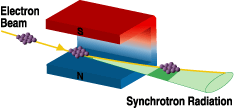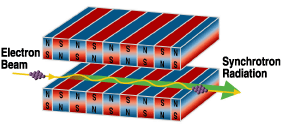Generation of Synchrotron Radiation
What is Synchrotron Radiation?
Synchrotron radiation (SR) is emitted from an electron traveling at almost the speed of light when its path is bent by a magnetic field. As it was first observed in a synchrotron in 1947, it was named "synchrotron radiation".
Generation of Synchrotron Radiation
Synchrotron radiation is emitted at a bending magnet or at an insertion device. The insertion device is comprised of rows of magnets with alternating polarity and is installed in a straight section of the electron orbit. There are two types of insertion devices, distinguished by magnetic field strength: the undulator and the wiggler.- Bending Magnet: Stored electrons run on a circular orbit and emit synchrotron radiation with a continuous spectrum when they encounter the bending magnet.

Synchrotron radiation produced at a bending magnet
- Undulator: The electron beam wiggles with a small deviation angle. As a result, ultra-bright and quasi-monochromatic light is obtained by the interference effect.

Synchrotron radiation produced at an undulator
- Wiggler: The electron beam wiggles with a large deviation angle. As a result, bright and spectrally continuous light with short wavelengths is obtained.
General Features of Synchrotron Radiation
Synchrotron radiation has the following features:
- Ultra-bright
- Highly directional
- Spectrally continuous (Bending Magnet/Wiggler) or quasi-monochromatic (Undulator)
- Linearly or circularly polarized
- Pulsed with controlled intervals
Last modified
2021-12-03 10:26